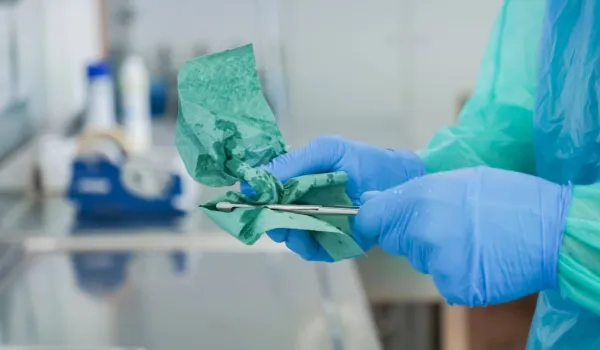
*This article is sponsored by Infinity Scrubs, and Concorde has no affiliated with them
If there is one thing that the outbreak of COVID-19 has proven, it's that the American healthcare system is vastly underprepared to deal with major healthcare crises. With frontline workers facing shortages of PPE equipment, not having the proper laundry additives to sanitize their scrubs, hospitals fearing not having enough ventilators and staff to care for critically ill patients and other challenges that have become apparent over the last several months, it's clear that major changes need to take place within the medical field to prepare for future crises.
Over the past few months alone, the healthcare industry has had to overcome numerous issues to save lives and slow the spread of the novel coronavirus. Changes have been happening at an astonishing rate, and it's clear that the post-COVID-19 medical field will look much different than it did before the outbreak of the novel coronavirus.
Whether it's a future pandemic, a resurgence of COVID-19 or the typical flu season, healthcare providers and facilities are changing the way things are done and taking steps to ensure that the industry is better prepared for the next crisis. Keep reading to learn more about how the medical field is adapting to prepare for future healthcare crises.
Enhanced Sterilization Techniques
Keeping things as sanitary as possible is always vital in healthcare settings. Thanks to the outbreak of the novel coronavirus and the ever-growing prevalence of antibiotic-resistant bacteria, however, it has become even more important than ever before.
In doctors' offices, hospitals and other medical facilities, workers are doubling up their efforts to sterilize high-touch areas. Infections that commonly travel via community spread–such as influenza and the common cold–tend to travel through the air in droplets. These droplets then land on surfaces or objects where they can easily be transferred to the nose, mouth or eyes. They also end up on surfaces when someone who is ill coughs or sneezes into their hand and then touches the surface.
To slow the spread, high-touch areas, including door handles, countertops, credit card machines, etc. are being sanitized more diligently than ever before. Things like magazines in waiting rooms may largely become a thing of the past simply because there is no efficient means of sanitizing them in between patients.
Enhanced sterilization techniques don't stop in the doctor's office, though. Many workers and employers have also gotten more serious about sanitizing work uniforms, including scrubs for men (1) and women, and are using things like laundry additives to more efficiently remove all traces of harmful germs and bacteria (2) from scrubs, jackets, etc.
Increased Use of Telehealth
Telehealth is something that's been long discussed but not used to nearly its full potential. State and federal regulations have made it difficult for it to become a truly accessible alternative to traditional face-to-face appointments. The COVID-19 outbreak has changed that, though.
With millions of people being asked to stay home and avoid overburdening emergency rooms and urgent care centers, the need for telehealth increased dramatically. Over the last few months, telehealth has finally begun to seriously come of age and become a viable alternative to going and visiting a doctor face-to-face. While not all issues can be handled remotely, telehealth is an excellent option for simple visits.
Telehealth has proven vital in the midst of COVID-19 and will remain that way even after the current crisis subsides. Being able to consult with a doctor from the comfort of your own home means that you don't have to face the risk of being exposed to germs, viruses and bacteria in a typical healthcare setting. This option also helps protect vital healthcare workers, which has proven essential during the current outbreak.
Maintaining telehealth services and making them more accessible to the elderly and at-risk people helps prevent or slow the spread of infectious disease. It also makes it possible for healthcare professionals to provide vital services during times of crisis without risking their own health.
Improved Care for Healthcare Workers
Before the onset of the coronavirus crisis, healthcare workers in virtually all positions were experiencing high levels of burnout (3). Unfortunately, it is an issue that has largely been ignored or, at the very least, not handled efficiently.
As COVID-19 began to spread and lead to some facilities being overrun with sick patients, already burnt-out workers struggled to keep up with the demand. And as the workers themselves started getting sick, there have been major concerns about there not being enough medical personnel to provide care to those who need it most.
In many areas, hospitals and other facilities are already taking steps to ensure that there are enough physicians and nurses to care for sick patients and give other employees a break. The federal government has also taken steps to ease restrictions on the workforce and expand capacity.
Moving forward, the healthcare industry seeks to eliminate issues with understaffing and ensure that there are enough workers to provide care for patients even if employees get sick or need time off. Across the board, efforts are being made to provide better care and additional resources–including personal protective equipment–to safeguard healthcare workers and protect them against burnout.
The Bottom Line
There is no denying that COVID-19 has changed the world in which we live. While it has had countless negative implications, it has also had the positive effect of driving much-needed change in the healthcare sector. It has become clear over the past few months that the United States healthcare system was vastly unprepared to deal with a major health crisis. However, steps are now being taken to ensure a much better response to future crises.
Footnotes:
- Infinity Scrubs- Men's page, https://www.infinityscrubs.com/men
- Infinity Scrubs- Smartboost page, https://www.infinityscrubs.com/smartboost
- The Washington Post, 'I have never felt so helpless': Front-line workers confront loss, https://www.washingtonpost.com/health/2020/06/07/health-care-workers-coronavirus-burnout/
Take The Next Step Towards a Brighter Future
We have a Concorde representative ready to talk about what matters most to you. Get answers about start dates, curriculum, financial aid, scholarships and more!




